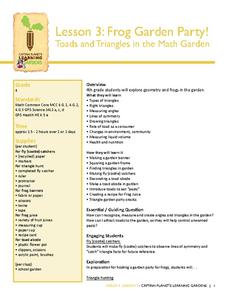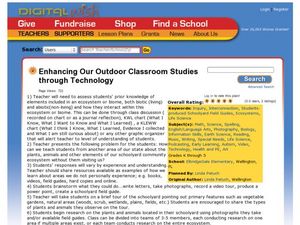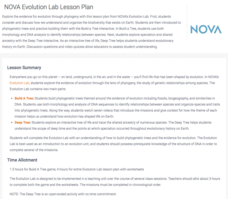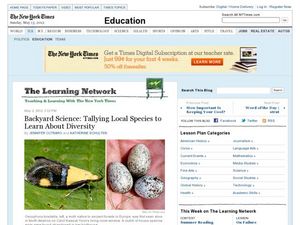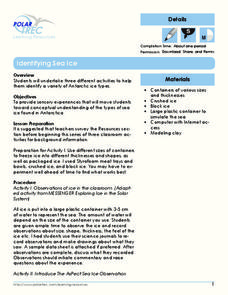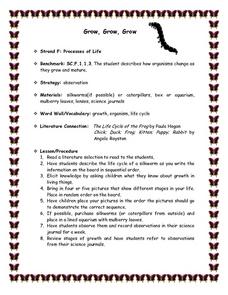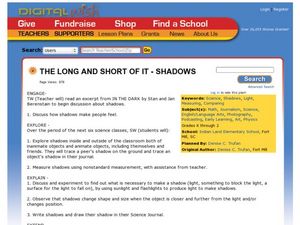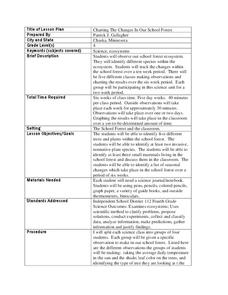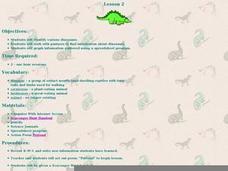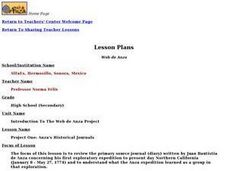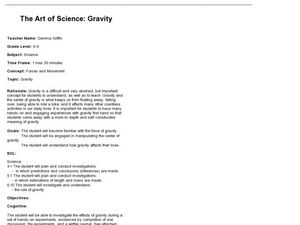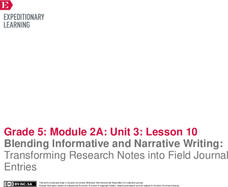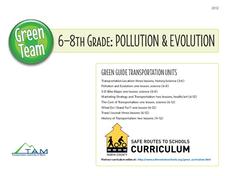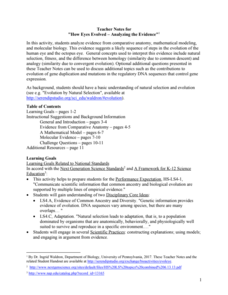Curated OER
Under the Sea
Young scholars imagine and describe fictitious sea animals that might live in the ocean. After reading an article, they reflect on new discoveries found in the ocean recently. Using the internet, they research the interdependence of...
Captain Planet Foundation
Frog Garden Party! Toads and Triangles in the Math Garden
It's frog party time! With frog banners, frog juice, and a triangle hunt, your garden party is sure to be both entertaining and educational. The lesson connects geometry, earth science, and delicious snacks to teach kids about ecosystems...
Curated OER
Data Collection
Students write a journal exercise that relates to pets. They collect information from each other in order to practice making and interpreting bar graphs. They Continue building different kinds of graphs with the group.
Curated OER
Enhancing Our Outdoor Classroom Studies through Technology
Combine science, math, and more using this resource. Learners use technology to share video and other information about their community with people throughout the state. They learn about the environment, identifying native plants, record...
PBS
NOVA Evolution Lab Lesson Plan
It doesn't matter if you look on land, in the air, underground, or in water—evolution is everywhere. Scholars complete worksheets with multiple question types as they progress through six online missions creating phylogenic trees.
Curated OER
Tallying Local Species to Learn About Diversity
Using this thoroughly-written plan, you can have your junior ecologists exploring local biodiversity. They take a journal outdoors to tally the species that they see. An article is included along with comprehension questions. The author...
Polar Trec
Identifying Sea Ice
Sea ice contains 17 sub-types based on age and various characteristics. Scholars observe ice floating in a simulated ocean and record their observations. Then, they view photographs of different types of sea ice and learn to...
Curated OER
The Mystery of the Missing Hummingbirds
Students record scientific observations in a science journal. In this season lesson, students make observations about each of the seasons and record in their journals. Students record organisms response to seasonal changes...
Curated OER
Grow, Grow, Grow
Students listen to literature selection, describe life cycle of silkworm, discuss what they know about growth in living things, observe silkworms for one week and record observations in science journals, and review stages of growth.
Curated OER
The Long and Short of It- Shadows
Students trace shadows. In this light and shadows lesson, students conduct an experiment to determine what a shadow is and what is necessary to make a shadow. Students observe how shadows change as well as write and draw shadows in their...
Curated OER
Denali Park Topographic Maps
Students construct a topographic map of the Denali National Park. They identify different elevations and record historic landmarks in student science journals.
Curated OER
So You Want To Travel To Namib
Students research and plan a trip to the Namibian desert. They watch and discuss a video, develop a list of the harsh conditions while viewing the film, identify the precautions needed for traveling in the Namib environment, and write...
Curated OER
Clouds
Second graders explain what a cloud is, how it is formed and what the various types of clouds are. They do an experiment which shows them how to "make" a cloud, and write in their science journals about a "crazy weather day."
Curated OER
Charting the Changes in Our School Forest
Fourth graders investigate the ecosystem and how forests are disappearing. For this environmental protection lesson, 4th graders analyze the changes in their school for 2 weeks. Students practice identifying trees, birds, and...
Curated OER
My Life As An Insect In Namib
Students examine the harsh living environment of the Namib Desert. They watch and discuss a video, record the types of insects observed in the video, record information about insects and animal adaptations in their science journals, and...
Curated OER
Dinosaur Scavenger Hunt
Students conduct research on dinosaurs and graph the information gathered using a spreadsheet program. In pairs they complete an Internet scavenger hunt, and record five facts about dinosaurs in their science journal.
Curated OER
Solar Matters II
Students research solar energy. For this solar energy lesson, students construct a KWL chart and research solar energy through various websites and related readings. Students complete a science journal page as an assessment.
Curated OER
The Water Cycle and Clementine
Third graders sing a piggyback song to explore the parts of the water cycle and then illustrate and label the water cycle in their science journals.
Curated OER
Anza's Historical Journals
Students review the journal of Juan Bautista de Anza. They reflect on his first exploratory expedition into present-day California.
Curated OER
The Art of Science: Gravity
Through a series of experiments and demonstrations, fifth graders will learn about gravity. They will make predictions, drop various objects, write down their observations, and try to understand gravity through balance. This lesson seems...
EngageNY
Blending Informative and Narrative Writing: Transforming Research Notes into Field Journal Entries
The fabulous four. Scholars learn the four key components for creating an excellent journal entry. They then work to create a journal entry rubric and participate in a mini lesson about organizing and outlining journal entries.
Safe Routes to School
Pollution & Evolution
Bring together a study of two major scientific topics with a lesson on the relationship between pollution and evolution. With the help of a PowerPoint presentation, hands-on activity. and class demonstration young scientists learn...
Curated OER
Evidence of Photosynthesis
Hands on science is the way to go! Learners conduct a lab experiment to help them explain how plants make food through photosynthesis. They test for the presence of starch in leaves using iodine solution and identify the basic things...
Serendip
How Eyes Evolved – Analyzing the Evidence
Octopodes existed for hundreds of thousands of years before humans, yet our eyes share many similarities. Scholars analyze the evidence to determine if the evolution of eyes best fits a homology or analogy model. They discuss the issue...
Other popular searches
- Elementary Science Journals
- Science Journals Set Up
- Making Science Journals
- Science Journals Rocks
- Space Science Journals
- Creating Science Journals
- Science Journals Trees
- Reasons for Science Journals

